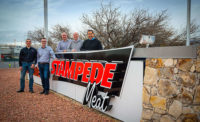Finding the right fit
This article focuses on those projects tied to initiatives that are critical for a company to remain competitive. They are typically longer in duration and involve all or multiple segments of the organization. They often include suppliers and customers and other outside stakeholders. Examples include a merger/acquisition, transformation integration (of many systems and operations), “re-engineering” effort, technology installation, performance/quality improvement program or even a strategic planning initiative.
Of course, it should be recognized that on a rare occasion, the efforts of these projects become “baked-in” to the way the organization conducts its day-to-day business. This would be the case, for instance, when an organization embraces its quality improvement program, and successfully makes it the “mindset” of everyone.
For a project team to be successful, it must not only accomplish its task on time and on budget, but it must involve its members so they are enthusiastic, engaged contributors.
Three questions become critically important!
- What must you do to “anchor” the intended project team effort?
- How should you go about putting it into action?
- How do you ensure your effort won’t get derailed or collapse, and fall short of hoped for results?
Understanding and choosing the “right” culture
In order to answer the first question above (“anchor” this project team so that it will succeed), you need to establish the right culture. That is a culture that will enable you to effectively achieve your objectives and do so in a way that optimizes individual capabilities and organizational resources.
Organizational culture is based on the underlying values and the actions the company employed to successfully deal with opportunities and threats in the past. The subsequent learning about “how to do things” becomes part of the fabric of the organization and shapes each element of it.
Figure 1 (see digital edition of this story, starting on page 20, for complete charts) presents a framework for understanding culture. As can be seen, the basic assumptions and core values form the foundation building blocks. These support more explicit values (what we espouse), which then become visible in the way we behave and in the signs, signals, language and rules we establish (artifacts).
Many culture attributes have been identified and promoted as the essential components needed for a highly effective organization. These “ideal” culture attributes include such varied qualities as integrity, leadership, dedication, service, communication, respect, character and honesty, teamwork, and technical ability.
This list is quite acceptable. But, the fact is it’s a bit like having the ingredients for a recipe without knowing the desired product. Just as we say, “Different strokes for different folks,” different cultures are required for different organizations.
Figure 2 (link to digital) presents a cultural continuum depicting different types of organizations in terms of functions and industries and the typical speed of change within those organizations –– slower/incremental versus rapid/seismic.
The important point is that there is no one-size-fits-all culture. But, the correct cultural fit is needed. Within the same industry or even within the same organization, cultures can differ greatly.
If your project team is working on a senior management-championed, high-profile, high-priority, resourced initiative such as those identified earlier, most likely you will be given significant discretion on how you achieve your objectives and deliver the expected results.
Business actually uses the term “skunk works” to designate a group within an organization charged with developing something innovative, and oftentimes quickly, with minimal management constraints. The distinguishing features of “skunk works” is a team doing things in an unconventional way while creating new constructs and guidelines that are used to accelerate expected results and generate breakthrough thinking.
Building culture and putting it into action
Talking about shaping behavior and adopting it as the right way to do things is one thing. Getting people to do it is quite another matter. Human nature is to keep doing things as we were.
If we want to achieve a goal, we must adhere to a path of action that we believe will bring us to that goal. And, we need to utilize structure, tools and techniques to help us get there. Think about achievements in your own life.
Our parents taught us to stay away from household dangers by using deterrents such as cabinet locks, outlet covers and disdainful stickers on poisons. They supported desirable behavior through recognition and reward. In most situations, a structure and related support or reinforcement mechanisms were used to drive the required behavior needed to achieve the objective. Building and sustaining your project team culture requires no less attention.
Figure 3 (link to digital) presents a framework/structure entitled “Business Effectiveness through Alignment and Management (BEAM).” This framework has proven very useful for understanding organizational functioning, and for identifying those components, which if modified, would help the organization be more effective.
As is apparent, it depicts the organization as an open system. Every organization is in business to take inputs and produce goods or services. The challenge for the organization is to create and sustain the culture, structure, processes, technology and people components that accelerate this transformation or “throughput.” The organization must also assess how it is doing by utilizing appropriate metrics.
The most striking feature in this BEAM framework is that culture is at the hub of organization/team dynamics. So, in essence, culture influences how each of the organizational components or “drivers” is designed. In turn, the design shapes what behavior is emphasized and rewarded, and which modes of operating are discouraged and constrained. In other words, there is alignment between the expressed values/culture and the way the organization operates.
What does all this mean for the project team, and for each of its members?
It means that a project team must first define its values, translate these espoused values into specific behaviors, and then establish the mechanisms and artifacts that drive those behaviors.
Avoiding collapse, derailment, failure
The project team needs to recognize that culture doesn’t just happen. It’s not a chance occurrence. Rather, it evolves and takes hold because it is being reinforced.
The framework and mechanisms used to keep project teams on track and on budget and help ensure that projects succeed can be used to build and sustain your preferred project culture. These include:
- The Project Management Office (PMO), which coordinates and drives the project teams and creates a strong linkage to the executive steering committee to ensure an integrated change effort. The PMO is responsible for, coordinating the work of project teams, resolving issues, and accelerating decisions. The PMO should serve as a “cultural gyroscope” making sure that project-related relationships, information and process exchanges, and decisions are consistent with the intended cultural values.
- The established Project Management Protocol (PMP), which guides each project through five core stages: Initiate, Plan, Execute, Control and Close. Each stage has its objectives, work requirements and expected results. Consequently, each stage has a set of stage-specific dynamics that must be successfully managed. As the team enters each PMP stage, the stage should be examined to identify inherent vulnerabilities and risks, and appropriate preventive measures and interventions should be planned and used when needed. It is imperative to remember that mismanagement of the “human dimension” is the most pernicious “killer” of team … and ultimately, organization success.
The stages of team development must be overlaid on the PMP project stages … adding to the complexity. All successful teams must go through the basic stages of team development
This has implications for determining:
- The most effective leadership style of sponsors and team leads at different stages of team development;
- The availability and type of training provided to everyone;
- The content and frequency of cultural messages and the cascading of those messages throughout the organization.
The fourth mechanism is to create measures and metrics to assess project team performance on the human and cultural dimensions in addition to the completion of tasks. And then to integrate these indicators into the routine project management process at designated “decision check points” or “stage gates,” and as part of any variance or exception reporting.
Finally, involve all stakeholders impacted by the project. These should include: executive sponsors and steering committee, PMO staff, team leads, project team participants, non-project team employees, suppliers and customers, and other relevant stakeholders. Remember that most people are fairly flexible and will adapt when given adequate information and time. No one likes to feel off-balance, disconnected or “taken for a ride.”
In conclusion, the PMO should utilize a framework such as BEAM or adapt it to other PMP to guide the project team through the typical stages of team development within the context of the project stages. Also, the executive sponsors and steering committee should be visible change champions, and provide the resources and latitude needed for the project team to achieve its task, and do so in alignment with the desired values and guiding principles of its culture.
Stuart M. Smith, Ph.D., is president of Targeted Performance Solutions LLC, a specialty management consulting firm of senior level practitioners dedicated to helping organizations enhance performance, achieve bottom-line growth and create and sustain their desired culture. For more information, contact him at (610) 256-2814 or stu.smith@tpsbeam.com.
Looking for a reprint of this article?
From high-res PDFs to custom plaques, order your copy today!






